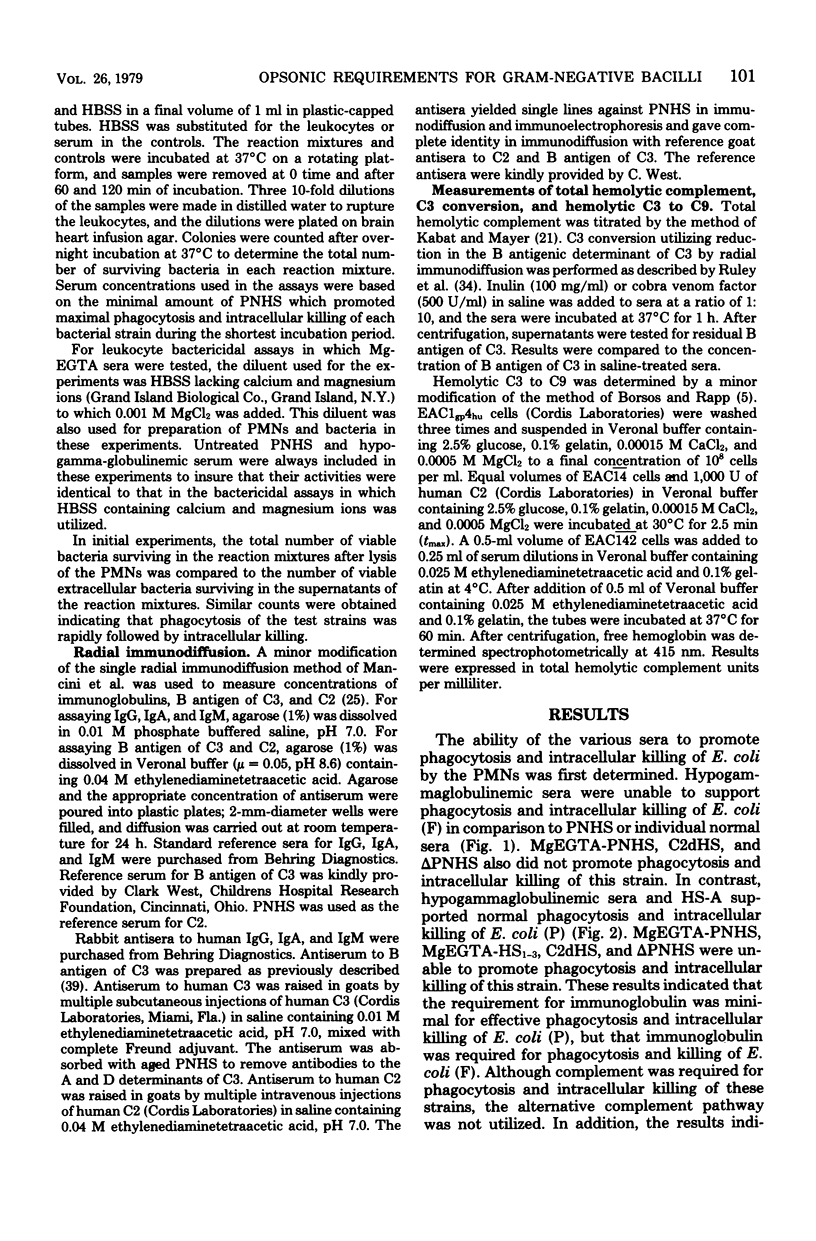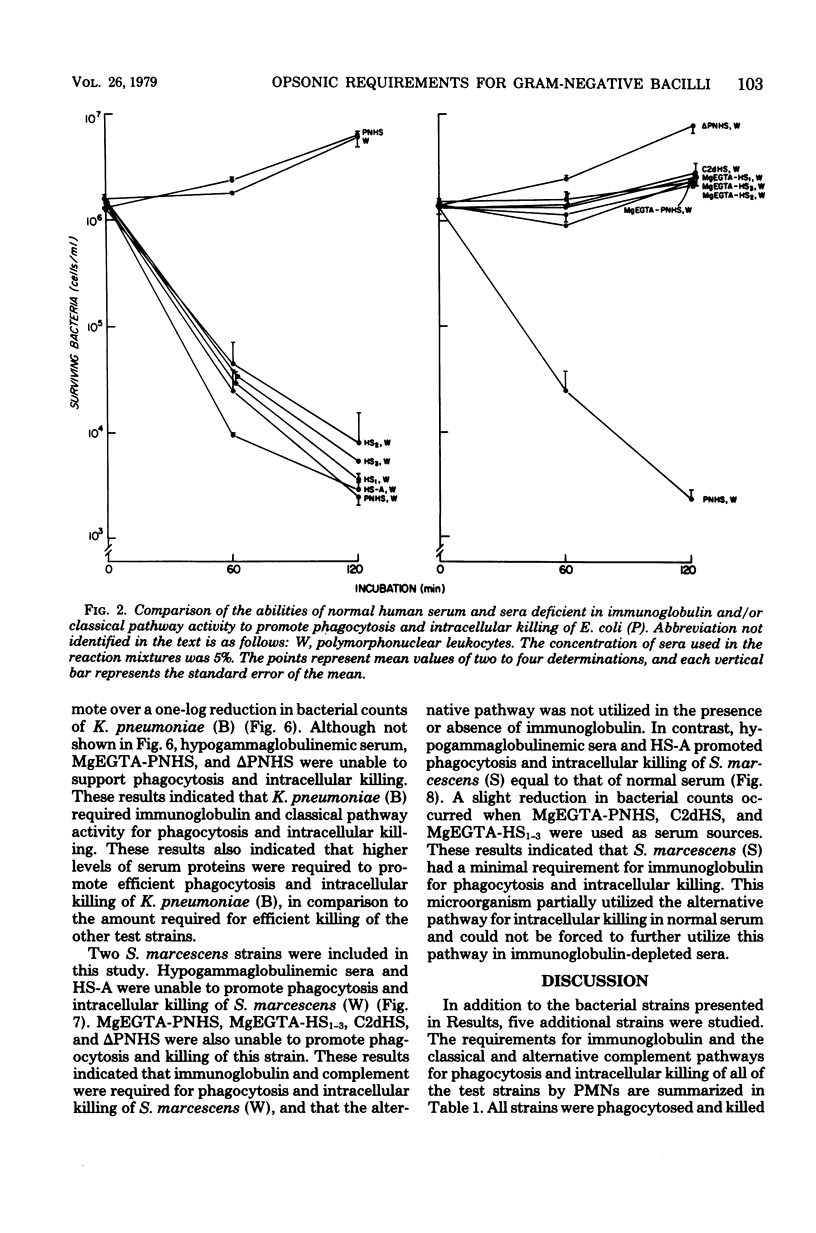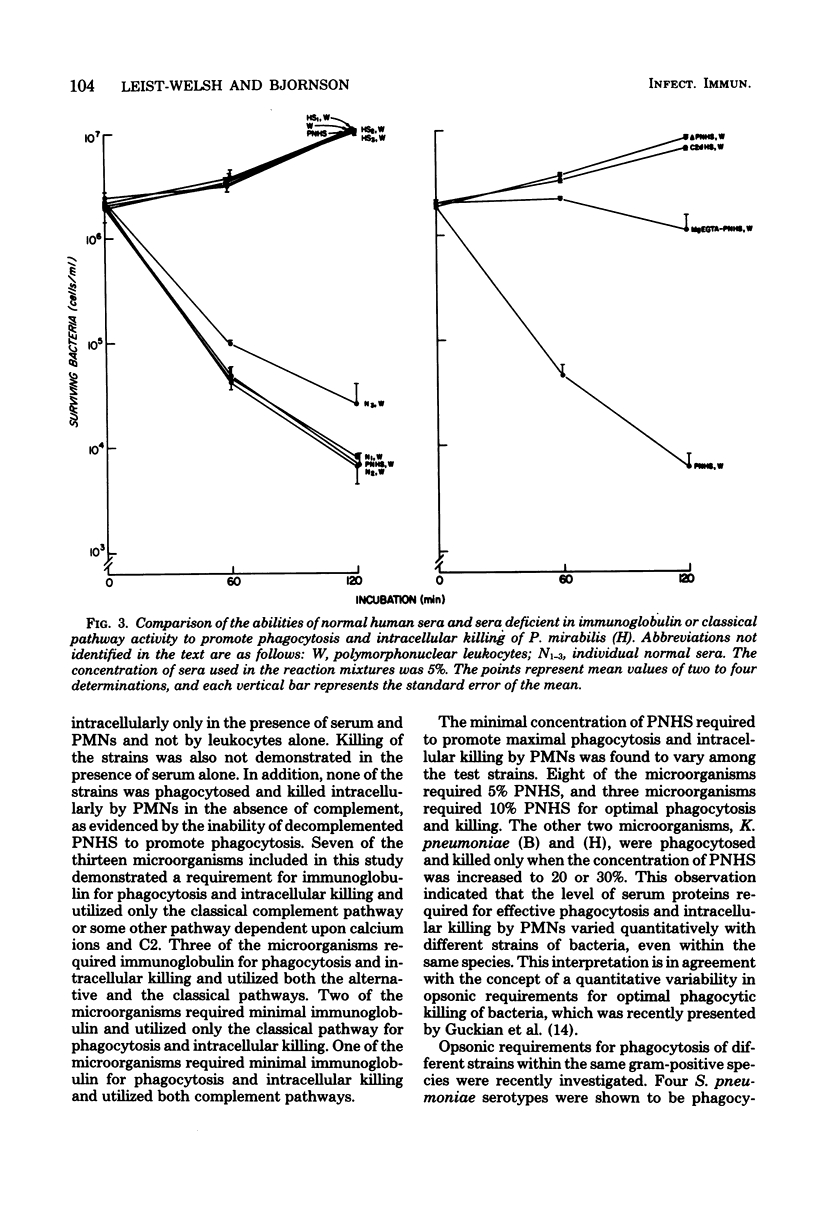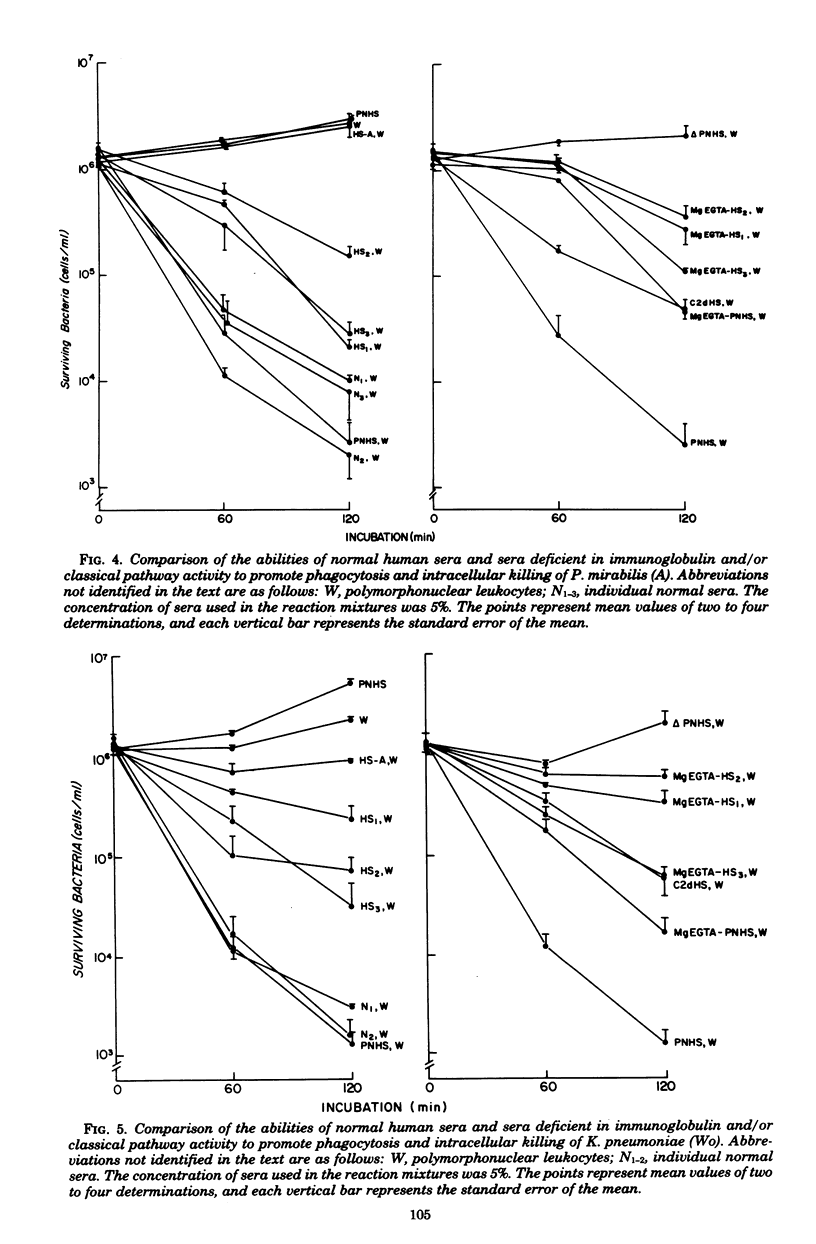Abstract
The requirements for immunoglobulin and the alternative and classical complement pathways for phagocytosis and intracellular killing of clinical isolates of Escherichia coli, Proteus mirabilis, Klebsiella pneumoniae, and Serratia marcescens by normal human polymorphonuclear leukocytes were determined. Human sera deficient in immunoglobulin or classical pathway activity, or both, were compared for their ability to promote phagocytosis os and killing of 13 bacterial strains by the polymorphonuclear leukocytes. Seven of the thirteen microorganisms required immunoglobulin for phagocytosis and killing and utilized only the classical complement pathway. Three required immunoglobulin and utilized both the classical and alternative pathways. The other three microorganisms required minimal immunoglobulin and utilized the alternative or classical pathway, or both. None of the microorganisms utilized the alternative pathway in immunoglobulin-deficient sera or could be forced to utilize this pathway in sera deficient in both immunoglobulin and classical pathway activity. These results demonstrated a heterogeneity in the requirements for immunoglobulin and the alternative and classical complement pathways for phagocytosis and intracellular killing by polymorphonuclear leukocytes among various genera of gram-negative aerobic bacilli, as well as among strains of the same species. In addition, the results suggested that a mechanism of classical pathway activation dependent upon minimal immunoglobulin participates in phagocytosis and intracellular killing of certain gram-negative aerobic bacilli.
Full text
PDF










Selected References
These references are in PubMed. This may not be the complete list of references from this article.
- Bjornson A. B., Michael J. G. Factors in human serum promoting phagocytosis of Pseudomonas aeruginosa. I. Interaction of opsonins with the bacterium. J Infect Dis. 1974 Nov;130 (Suppl)(0):S119–S126. doi: 10.1093/infdis/130.supplement.s119. [DOI] [PubMed] [Google Scholar]
- Bode F. R., Paré J. A., Fraser R. G. Pulmonary diseases in the compromised host. A review of clinical and roentgenographic manifestations in patients with impaired host defense mechanisms. Medicine (Baltimore) 1974 Jul;53(4):255–293. doi: 10.1097/00005792-197407000-00002. [DOI] [PubMed] [Google Scholar]
- Bodey G. P., Rodriguez V., Chang H. Y., Narboni Fever and infection in leukemic patients: a study of 494 consecutive patients. Cancer. 1978 Apr;41(4):1610–1622. doi: 10.1002/1097-0142(197804)41:4<1610::aid-cncr2820410452>3.0.co;2-b. [DOI] [PubMed] [Google Scholar]
- Borsos T., Rapp H. J. Immune hemolysis: a simplified method for the preparation of EAC'4 with guinea pig or with human complement. J Immunol. 1967 Aug;99(2):263–268. [PubMed] [Google Scholar]
- Cooper N. R., Morrison D. C. Binding and activation of the first component of human complement by the lipid A region of lipopolysaccharides. J Immunol. 1978 Jun;120(6):1862–1868. [PubMed] [Google Scholar]
- DuPont H. L., Spink W. W. Infections due to gram-negative organisms: an analysis of 860 patients with bacteremia at the University of Minnesota Medical Center, 1958-1966. Medicine (Baltimore) 1969 Jul;48(4):307–332. doi: 10.1097/00005792-196907000-00003. [DOI] [PubMed] [Google Scholar]
- Ehrnst A. Separate pathways of C activation by measles virus cytotoxic antibodies: subclass analysis and capacity of F(ab) molecules to activate C via the alternative pathway. J Immunol. 1978 Sep;121(3):1206–1212. [PubMed] [Google Scholar]
- Fine D. P., Marney S. R., Jr, Colley D. G., Sergent J. S., Des Prez R. M. C3 shunt activation in human serum chelated with EGTA. J Immunol. 1972 Oct;109(4):807–809. [PubMed] [Google Scholar]
- Finland M. Changing ecology of bacterial infections as related to antibacterial therapy. J Infect Dis. 1970 Nov;122(5):419–431. doi: 10.1093/infdis/122.5.419. [DOI] [PubMed] [Google Scholar]
- Forsgren A., Quie P. G. Influence of the alternate complement pathway in opsonization of several bacterial species. Infect Immun. 1974 Aug;10(2):402–404. doi: 10.1128/iai.10.2.402-404.1974. [DOI] [PMC free article] [PubMed] [Google Scholar]
- Forsgren A., Quie P. G. Opsonic activity in human serum chelated with ethylene glycoltetra-acetic acid. Immunology. 1974 Jun;26(6):1251–1256. [PMC free article] [PubMed] [Google Scholar]
- Giebink G. S., Verhoef J., Peterson P. K., Quie P. G. Opsonic requirements for phagocytosis of Streptococcus pneumoniae types VI, XVIII, XXIII, and XXV. Infect Immun. 1977 Nov;18(2):291–297. doi: 10.1128/iai.18.2.291-297.1977. [DOI] [PMC free article] [PubMed] [Google Scholar]
- Guckian J. C., Christensen W. D., Fine D. P. Evidence for quantitative variability of bacterial opsonic requirements. Infect Immun. 1978 Mar;19(3):822–826. doi: 10.1128/iai.19.3.822-826.1978. [DOI] [PMC free article] [PubMed] [Google Scholar]
- HIRSCH J. G., STRAUSS B. STUDIES ON HEAT-LABILE OPSONIN IN RABBIT SERUM. J Immunol. 1964 Jan;92:145–154. [PubMed] [Google Scholar]
- Hill A. W., Shears A. L., Hibbitt K. G. The requirement of specific antibody for the killing of E. coli by the alternate complement pathway in bovine serum. Immunology. 1978 Jan;34(1):131–136. [PMC free article] [PubMed] [Google Scholar]
- Ingwer I., Petersen B. H., Brooks G. Serum bactericidal action and activation of the classic and alternate complement pathways by Neisseria gonorrhoeae. J Lab Clin Med. 1978 Aug;92(2):211–220. [PubMed] [Google Scholar]
- Jasin H. E. Human heat labile opsonins: evidence for their mediation via the alternate pathway of complement activation. J Immunol. 1972 Jul;109(1):26–31. [PubMed] [Google Scholar]
- Johnson F. R., Agnello V., Williams R. C., Jr Opsonic activity in human serum deficient in C2. J Immunol. 1972 Jul;109(1):141–145. [PubMed] [Google Scholar]
- Joseph B. S., Cooper N. R., Oldstone M. B. Immunologic injury of cultured cells infected with measles virus. I. role of IfG antibody and the alternative complement pathway. J Exp Med. 1975 Apr 1;141(4):761–774. [PMC free article] [PubMed] [Google Scholar]
- Kierszenbaum F., Weinman D. Antibody-independent activation of the alternative complement pathway in human serum by parasitic cells. Immunology. 1977 Feb;32(2):245–249. [PMC free article] [PubMed] [Google Scholar]
- Klainer A. S., Beisel W. R. Opportunistic infection: a review. Am J Med Sci. 1969 Dec;258(6):431–456. doi: 10.1097/00000441-196912000-00007. [DOI] [PubMed] [Google Scholar]
- Loos M., Bitter-Suermann D., Dierich M. Interaction of the first (C1), the second (C2) and the fourth (C4) component of complement with different preparations of bacterial lipopolysaccharides and with lipid A. J Immunol. 1974 Mar;112(3):935–940. [PubMed] [Google Scholar]
- Mancini G., Carbonara A. O., Heremans J. F. Immunochemical quantitation of antigens by single radial immunodiffusion. Immunochemistry. 1965 Sep;2(3):235–254. doi: 10.1016/0019-2791(65)90004-2. [DOI] [PubMed] [Google Scholar]
- March S. C., Parikh I., Cuatrecasas P. A simplified method for cyanogen bromide activation of agarose for affinity chromatography. Anal Biochem. 1974 Jul;60(1):149–152. doi: 10.1016/0003-2697(74)90139-0. [DOI] [PubMed] [Google Scholar]
- Mayer M. M. The complement system. Sci Am. 1973 Nov;229(5):54–66. doi: 10.1038/scientificamerican1173-54. [DOI] [PubMed] [Google Scholar]
- Medicus R. G., Schreiber R. D., Götze O., Müller-Eberhard H. J. A molecular concept of the properdin pathway. Proc Natl Acad Sci U S A. 1976 Feb;73(2):612–616. doi: 10.1073/pnas.73.2.612. [DOI] [PMC free article] [PubMed] [Google Scholar]
- Morrison D. C., Kline L. F. Activation of the classical and properdin pathways of complement by bacterial lipopolysaccharides (LPS). J Immunol. 1977 Jan;118(1):362–368. [PubMed] [Google Scholar]
- Peterson P. K., Wilkinson B. J., Kim Y., Schmeling D., Quie P. G. Influence of encapsulation on staphylococcal opsonization and phagocytosis by human polymorphonuclear leukocytes. Infect Immun. 1978 Mar;19(3):943–949. doi: 10.1128/iai.19.3.943-949.1978. [DOI] [PMC free article] [PubMed] [Google Scholar]
- Platts-Mills T. A., Ishizaka K. Activation of the alternate pathway of human complements by rabbit cells. J Immunol. 1974 Jul;113(1):348–358. [PubMed] [Google Scholar]
- Polhill R. B., Jr, Newman S. L., Pruitt K. M., Johnston R. B., Jr Kinetic assessment of alternative complement pathway activity in a hemolytic system. II. Influence of antibody on alternative pathway activation. J Immunol. 1978 Jul;121(1):371–376. [PubMed] [Google Scholar]
- Root R. K., Ellman L., Frank M. M. Bactericidal and opsonic properties of C4-deficient guinea pig serum. J Immunol. 1972 Sep;109(3):477–486. [PubMed] [Google Scholar]
- Ruley E. J., Forristal J., Davis N. C., Andres C., West C. D. Hypocomplementemia of membranoproliferative nephritis. Dependence of the nephritic factor reaction on properdin factor B. J Clin Invest. 1973 Apr;52(4):896–904. doi: 10.1172/JCI107254. [DOI] [PMC free article] [PubMed] [Google Scholar]
- Stevens P., Huang S. N., Welch W. D., Young L. S. Restricted complement activation by Escherichia coli with the K-1 capsular serotype: a possible role in pathogenicity. J Immunol. 1978 Dec;121(6):2174–2180. [PubMed] [Google Scholar]
- Valdivieso M., Gil-extremera B., Zornoza J., Rodriquez V., Bodey G. P. Gram-negative bacillary pneumonia in the compromised host. Medicine (Baltimore) 1977 May;56(3):241–254. doi: 10.1097/00005792-197705000-00005. [DOI] [PubMed] [Google Scholar]
- Verhoef J., Peterson P., Kim Y., Sabath L. D., Quie P. G. Opsonic requirements for staphylococcal phagocytosis. Heterogeneity among strains. Immunology. 1977 Aug;33(2):191–197. [PMC free article] [PubMed] [Google Scholar]
- West C., Davis N. C., Forristal J., Herbst J., Spitzer R. Antigenic determinants of human beta-1c and beta-1g-globulins. J Immunol. 1966 Apr;96(4):650–658. [PubMed] [Google Scholar]
- Williams R. C., Jr, Quie P. G. Opsonic activity of agammaglobulinemic human sera. J Immunol. 1971 Jan;106(1):51–55. [PubMed] [Google Scholar]
- Young L. S., Armstrong D. Human immunity to Pseudomonas aeruginosa. I. In-vitro interaction of bacteria, polymorphonuclear leukocytes, and serum factors. J Infect Dis. 1972 Sep;126(3):257–276. doi: 10.1093/infdis/126.3.257. [DOI] [PubMed] [Google Scholar]


